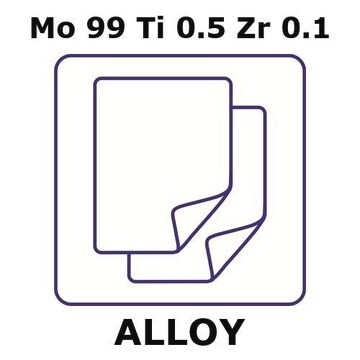266922
Molybdenum
foil, thickness 0.1 mm, ≥99.9% trace metals basis
Synonym(s):
Molybdenum element
Sign Into View Organizational & Contract Pricing
All Photos(1)
About This Item
Empirical Formula (Hill Notation):
Mo
CAS Number:
Molecular Weight:
95.94
EC Number:
MDL number:
UNSPSC Code:
12141727
PubChem Substance ID:
NACRES:
NA.23
Recommended Products
Quality Level
Assay
≥99.9% trace metals basis
form
foil
resistivity
5.0 μΩ-cm, 20°C
thickness
0.1 mm
bp
4612 °C (lit.)
mp
2617 °C (lit.)
density
10.3 g/mL at 25 °C (lit.)
SMILES string
[Mo]
InChI
1S/Mo
InChI key
ZOKXTWBITQBERF-UHFFFAOYSA-N
General description
Mo foils are lightweight and flexible, hence desirable for space applications. Mo foil may be used as a substrate for the fabrication of CdS-CdTe solar cells. Interaction of selenium, arsenic hydrides, stibine and bismuthine with Mo foil was investigated by atomic absorption spectroscopy. Mo foils may be used to generate metal diffusion bonding in silicon carbide/silicon carbide (SiC/SiC) joints.
Quantity
100×100 mm (approximately 10.2 g)
Storage Class Code
13 - Non Combustible Solids
WGK
nwg
Flash Point(F)
Not applicable
Flash Point(C)
Not applicable
Personal Protective Equipment
dust mask type N95 (US), Eyeshields, Gloves
Certificates of Analysis (COA)
Search for Certificates of Analysis (COA) by entering the products Lot/Batch Number. Lot and Batch Numbers can be found on a product’s label following the words ‘Lot’ or ‘Batch’.
Already Own This Product?
Find documentation for the products that you have recently purchased in the Document Library.
Customers Also Viewed
Design issues in the fabrication of CdS?CdTe solar cells on molybdenum foil substrates.
Singh VP and McClure JC
Solar Energy Materials and Solar Cells, 76, 363-385 (2003)
Flexural Strength and Shear Strength of Silicon Carbide to Silicon Carbide Joints Fabricated by a Molybdenum Diffusion Bonding Technique.
Cockeram BV, et al.
Journal of the American Ceramic Society. American Ceramic Society, 88(7), 1892-1899 (2006)
Trapping of hydride forming elements within miniature electrothermal devices: part I. investigation of collection of arsenic and selenium hydrides on a molybdenum foil strip
Docekal B and Selecka A
Spectrochimica Acta. Part B: Atomic Spectroscopy, 59(4), 487-495 (2004)
Trapping of hydride forming elements within miniature electrothermal devices. Part 3. Investigation of collection of antimony and bismuth on a
molybdenum foil strip following hydride generation
Krejci P, et al.
Spectrochimica Acta. Part B: Atomic Spectroscopy, 61, 444-449 (2006)
Phillip Ringel et al.
The Journal of biological chemistry, 288(20), 14657-14671 (2013-03-30)
Nitrate reductase (NR) is a complex molybdenum cofactor (Moco)-dependent homodimeric metalloenzyme that is vitally important for autotrophic organism as it catalyzes the first and rate-limiting step of nitrate assimilation. Beside Moco, eukaryotic NR also binds FAD and heme as additional
Our team of scientists has experience in all areas of research including Life Science, Material Science, Chemical Synthesis, Chromatography, Analytical and many others.
Contact Technical Service



